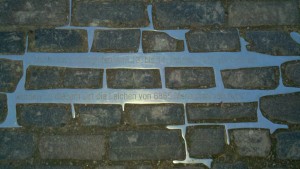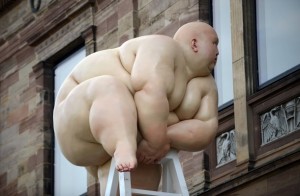Today is the Day of German Unity, the Tag der deutschen Einheit. Effective October 3, 1990, the Deutsche Demokratische Republik, the DDR, or the GDR in its English rendering (but also known among a certain generation of Germans as the “Sowjetische Besatzungszone,” the Soviet Occupation Zone, or sometimes simply “die Zone”) merged with and into the Bundesrepublik Deutschland, the Federal Republic of Germany. Once again, for better or worse, Europe had a single, compact (much more compact than used to be the case) mass of German united into one social and economic unit.
It would be idle to pretend that this development was welcomed universally outside Germany. I still recall a college professor of mine, who as an infantry grunt had fought his way into Germany during the war, sort of wistfully (and not without an unmistakable note of satisfaction in his voice) observe that, “When I think about a divided Germany I get a very peaceful feeling.” Even before 1990 West Germany was the economic powerhouse of the continent; what, one could be excused from asking, would be the effect of adding to them the further human and economic resources of a crew that had been conveniently sealed off behind barbed wire (literally) for 45 years? Still today the notion of Germany as the 400-pound gorilla in the room makes some nervous. The Italian prime minister as recently as this past week was actually suggesting Germany’s departure from the Euro zone would be desirable. Too hegemonic. Too prone to throw its weight about. Pay attention to the Greeks and you’ll hear much the same thing. Those dastardly Germans! You ask them to foot the bill and the next thing they’re telling you that you can’t retire with full pay at age 55! How dare they!! And so forth.
What West Germany actually got was the headache of dealing with socialism’s corrosive effects on an entire chunk of their country. The Ostzone has been at best slightly better than an economic wash for the west for 22 years now; at worst it’s been a sump hole. For starts the public infrastructure was in a disastrous condition. In February, 1986 I spent a week or so being herded around East Germany. We visited Eisenach (home of the Trabant, a two-stroke powered (if that’s the right word to use) econobox piece of crap that was the best the east could do for a “car,” and you still had to get in line for several years for the privilege of hating your very own), Leipzig, Dresden, and finally East Berlin. I paid attention to things. Paint peeling, rust icicles hanging down, busted rivets, patchwork everything: it was obvious that no one had been keeping the joint up since 1945. Even the places they shepherded us (and you must remember that the commies spared no effort to impress western visitors; they very, very much put their best foot forward, shod as best they were able) were, with the exception of re-built historical structures, distinctly seedy.
You can sand-blast bridge girders (which I paid particular attention to) and paint them. You can drill out rusted rivets and bolts and replace them. You can wash the windows. Etc. What has proven harder, I will suggest, is undoing the effects of two full generations grown up under socialism, almost three. The children born in, say, 1938 or later have no practical recollection of anything other than Nazi or Soviet rule. They would have reached adulthood in 1958; their children would have reached adulthood in 1978; that generation’s children could have been as old as 12 by the time of reunification. Twelve isn’t too late, but it’s deep into the third quarter of forming a person’s character.
Last year I went back to the former Ostzone for the first time since 1986; specifically, I wanted to visit the re-built Frauenkirche in Dresden (teaser: future blog post coming). So I grabbed me a train and headed thither. Ended up staying in a hotel just a couple of blocks from the train station, in a building that was one of the very few in that entire part of the city to survive the bombing intact. But that’s not germane to this post.
Part of the attraction for me of riding trains is that you get to see folks’ back yards. Drive down the road and you get to see the fronts of their houses. There’s something inherently Potemkin village about the fronts of properties. Not that that’s necessarily a bad thing; it prompts people to cut their grass, after all. But if you want to see a better reflection of how people actually live, peek around the corner. And no one who can avoid it builds his house or his business to face out onto the train tracks.
For those who’ve never visited Germany, at least the western part of it, one of the strongest impressions is how well taken care of the place is. You don’t see broken windows, or boarded up windows, or obviously broken things just left as they are, or stuff left out to rust or rot in the weather. The overgrown fence line or the barn thirty degrees out of square is a sight you don’t see in Germany (or, by the way, in parts of the U.S. that were settled largely by Germans . . . cultural DNA lasts, folks). Even in the backs of farm houses you won’t see piles of miscellaneous Stuff lying about. If they can’t move it indoors they’ll stack it neatly and lash a tarpaulin over it. If it’s a vehicle or large equipment that can’t be put up they’ll park it, neatly and out of the way. If something breaks they’ll either jump on it and fix it as good as or better than it was, or if they can’t they’ll tear it down and do something else.
The former border facilities (auf deutsch: Grenzanlagen) — the watch towers, barbed wire and electric fences, tank traps, mine fields, and so forth — are long gone of course. But it was still possible to note when one was in the old Ostzone. Gaping windows with broken glass still in them. Sheets of metal tacked over holes in roofs. Roof lines as sway-backed as any broken-down nag. Obviously vacant buildings surrounded by over-grown weeds. Stuff and Junk left to lie wherever it fell out of the hands of the last person to drop it. Things, in other words, that just screamed no one’s taking care of this. Well, you can write some of that off, surely, to economic depression (but seriously, for 21 years it’s been there?) and the sheer cost of trying to fix things that were built pre-1945 and scarcely modernized since (just ask some university facilities manager what it’s like dealing with that wonderful august building that Joe Alumnus built for the school in 1915).
What you can’t write off is people’s behavior. There are two market squares in downtown Dresden. The Neumarkt, or New Market, is where the Frauenkirche towers over everything, and that’s a hustling, bustling, over-run with tourist activity venue. They’re still building back the streets and buildings destroyed in February, 1945 and so a good portion of it is construction site, fenced off appropriately. The Altmarkt, or Old Market, is several blocks away (the site of the Frauenkirche was originally outside the city’s walls, and of course the original market square would have been within them; hence the two markets so close together). It’s much larger than the newer square, probably close to 100 yards on a side; among its features is a rectangular outline in red-colored stones, maybe forty or fifty feet by twenty or so (I didn’t measure it, so don’t hold me to that). Between some of the pavement stones within the rectangle they poured molten metal, with an inscription:

“After the attacks of 13 to 14 February 1945 on Dresden the corpses of 6,865 people were burned at this location.”
That location was one of dozens where they burned the corpses, but that’s also not really relevant to the post. What’s really relevant is that at 7:45 a.m. on a Tuesday morning, on the entire Altmarkt there were a total of six vendors, hawking cooked sausage and similar things. At that same hour in any sizeable city in western Germany you can’t swing a cat without knocking over someone’s stall of fresh produce, typically from all over Europe, fresh meats, flowers, local crafts, etc. I mean, even in a city of starveling students like Freiburg you can’t take more than a few steps in a given direction for all the people buying and selling stuff.
Twenty-one years after reunification, in the capital city of Saxony, six measly guys flogging over-cooked sausages is the best they can do? That can only be attributed to a lack of entrepreneurial spirit, and that lack can only be attributed to 45 years of ruthlessly crushing anyone who dared to climb out of the place where the central planners had shackled him. Folks, the existence of two Germanies for 45 years is as close to a perfect experiment as you’ll get (the Koreas aren’t even as good because North Korea is a hermit state, sealing itself off even from its fellow commie states, and East Germany was the Warsaw Pact showplace). Same society, same culture, same history, similar levels of destruction. Two different economic systems for a prolonged period. How’d it work out? How is it still working out?
So yes, Virginia, Germany has achieved once more the “Einigkeit” (unity) of the Deutschlandlied that remains their national anthem (one does not sing the first verse any more, of course); however picayunish some of their laws may appear to Americans (particularly the laws relating to freedom of expression and affiliation, which are aftergrowths of the Nazi era), they’ve got their Recht (justice) and their Freiheit (freedom). But 80 years on they’re still working through the consequences of their embrace of state-controlled collectivism and tyranny. Cultural DNA lasts, and so does social trauma. It took America almost exactly 100 years to begin lurching past the living impact of the Civil War and slavery. A good bit of Germany’s history in the 20th Century has strands tracing back to the Napoleonic conquest and subsequent liberation, and in some cases even further back, to the Thirty Years’ War.
Ideas have consequences. We should be very careful about which ones we embrace and how quickly we let ourselves be tempted by someone’s promise to “re-forge” us, to “transform” us, to guide (and it’s always guiding us, as if we’re not capable of finding our own way into our future) us to the sunny uplands of some utopian vision. We should be profoundly skeptical of such as promise those things, lest they mean them, lest our remote descendants spend their lives suffering their effects.


